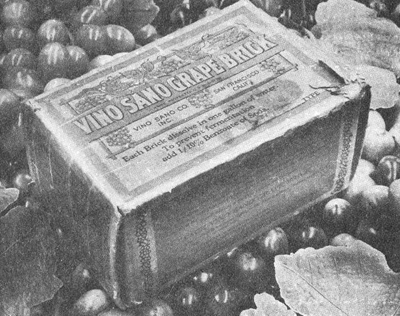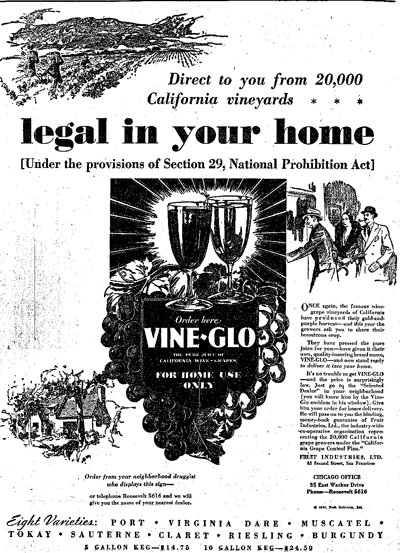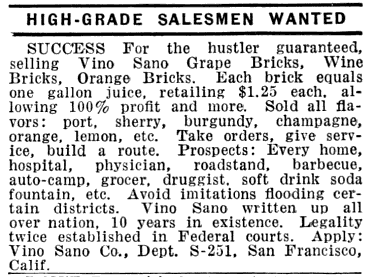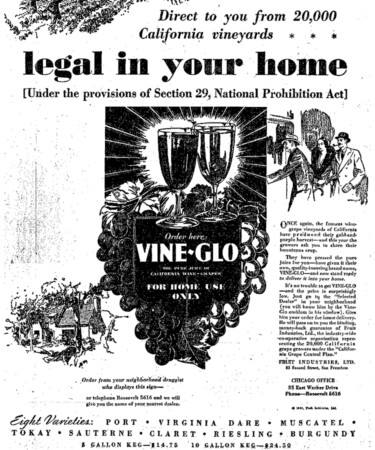When Prohibition finally went into effect on January 16, 1920, those who owned American vineyards for the sole purpose of turning those grapes into wine faced a dilemma: tear up the vines and plant something else, or try and find a way to still make a profit from the grapes with the hope that ban on booze didn’t last very long.
This conundrum was especially felt among the vintners of the Napa Valley, who by 1920 were already making a good portion of America’s wine. Here was the problem: if these winemakers tore up their vines in search of other profits only to see Prohibition overturned a few years later, if they replanted, it could take up to ten years for those vines to start producing the kind of quality fruit they were currently producing.
Some vineyard owners just couldn’t risk it, and as soon as Prohibition was passed, they tore up their vineyards and planted orchards. But those winemakers who decided instead to stick it out came up with an ingenious way to sell their grapes and still legally make wine, becoming rich in the process.

U.S. law stipulated that grapes could be grown if and only if those grapes were used for non-alcoholic consumption. If it was determined that someone instead used those grapes to make booze, and the vineyard owner who sold the individual the grapes was aware of this, both the grape grower and the winemaker could find themselves in jail. However, if the grape grower gave clear warning that the grapes were not to be used for the creation of alcohol and those grapes passed through enough hands so that even if the end result was wine, the grape grower did not know the bootlegger’s intentions, the grower was in the clear.
The Volstead Act also stipulated that the grape growers themselves could make juice and juice concentrate only if those products were used for non-alcoholic consumption. So the vineyards could still make non-alcoholic wine and that wine could theoretically be turned into alcohol by consumers as long as the winemakers gave clear warning that this was illegal, and they had no knowledge of the end consumers’ intentions. With these loopholes in place, the creation of “wine bricks” and, in turn, the ability for U.S. citizens to continue consuming wine came to be.
A wine brick was a brick of concentrated grape juice – which was completely legal to produce – that consumers could dissolve in water and ferment in order make their own vino. But not every consumer knew how to make wine, so how did consumers know what to do? The instructions were printed directly on the packaging, but these instructions were masked as a warning of what not to do with the product. An ingenious way to get around the law.

If you were to purchase one of these bricks, on the package would be a note explaining how to dissolve the concentrate in a gallon of water. Then right below it, the note would continue with a warning instructing you not to leave that jug in the cool cupboard for 21 days, or it would turn into wine. That warning was in fact your key to vino, and thanks to loopholes in Prohibition legislation, consuming 200 gallons of this homemade wine for your personal use was completely legal, it just couldn’t leave your home – something wine brick packages were also very careful to remind consumers. Besides the “warning,” wine brick makers such as Vino Sano were very open about what they knew their product was to be used for, even including the flavors – such as Burgundy, Claret and Riesling – one might encounter if they mistakenly left the juice to ferment.
The result of these wine brick was that many people, including the famous Beringer Vineyards, became incredibly rich. This is because the demand for grapes and these concentrate products didn’t fall when Prohibition hit, it rose, but there were fewer people to keep up with the supply, since several winemakers had already torn up their vineyards to plant orchards. By 1924, the price per ton was a shocking $375, a 3,847% increase in price from the pre-Prohibition price tag of only $9.50.

As prices rose, people from across the country rushed to Napa to get into the grape game. One such person was Cesare Mondavi, a grocer from Minnesota who saw the fortune that could be made and moved his entire family to California to take part. Due in large part to Prohibition, the Mondavi wine dynasty was born. This dynasty and others created thanks to Prohibition insured that California’s wine industry survived and even thrived during America’s dry spell.
